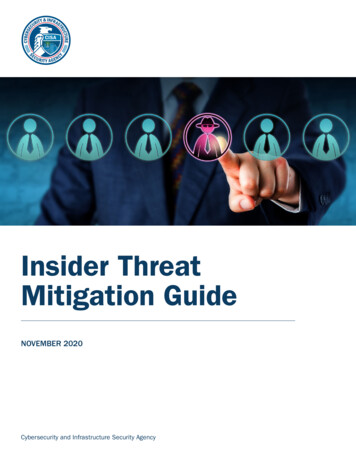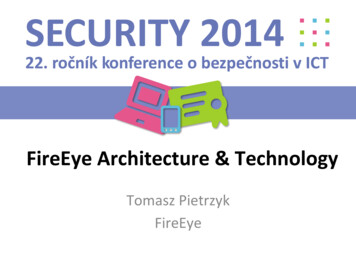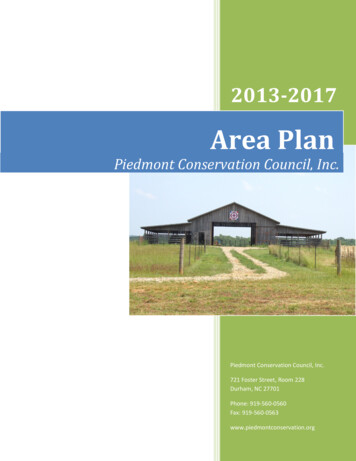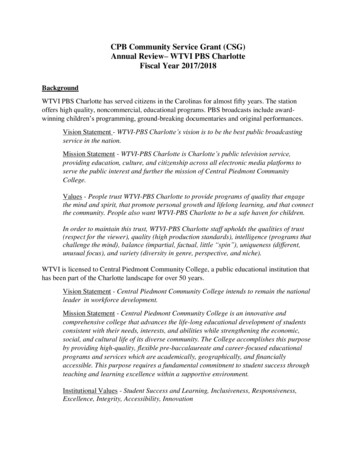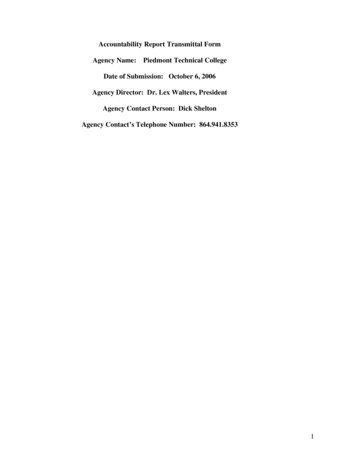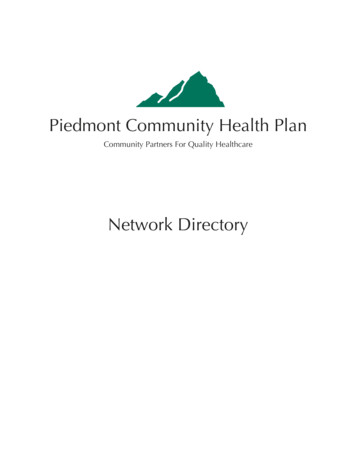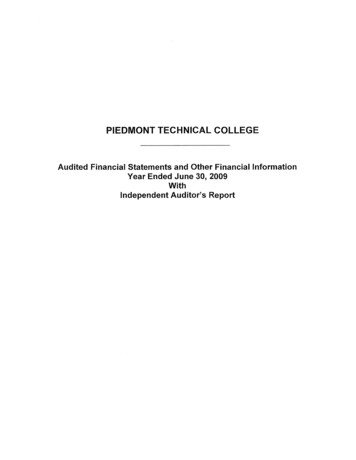
Transcription
THREATASSESSMENTMANUALPiedmont Virginia Community CollegeThreat Assessment TeamLast Revised: September 2013www.pvcc.edu/docs/policies/threat assessment manual.pdf
PIEDMONT VIRGINIA COMMUNITY COLLEGETHREAT ASSESSMENT PROCEDURESEffective: January 2012PURPOSEThe purpose of the threat assessment procedures is to provide guidelines for threatassessment on the Piedmont Virginia Community College (PVCC) campus and identifyresources, programs, procedures and safeguards that will ensure the safety and security ofthe PVCC community.OVERVIEWThe Code of Virginia (§23-9.2:10) requires each institution of higher education to have botha violence prevention plan and a threat assessment team on campus that will implementassessment, action, intervention and follow-up in all cases that involve threatening or violentbehavior. In contrast to PVCC’s violence prevention policy, the threat assessmentprocedures pertain to individual case management.Piedmont Virginia Community College is committed to providing an environment thatprotects the security and safety of the campus community. Violence, intimidation, or threatsof violence, both specific and implied, will not be tolerated on the campus, and the collegereserves the right to take strong and preventive measures to prevent violence before itoccurs. The PVCC Threat Assessment Team (TAT) has been established as part of PVCCXII – 2.0 Violence Prevention and Threat Assessment Policy(http://www.pvcc.edu/docs/policies/policy violence prevention.pdf).THREAT ASSESSMENT TEAMThe PVCC Threat Assessment Team seeks to improve the safety and security of thecampus through a multidisciplinary approach to identifying, managing and monitoringpersons and situations that may pose a threat to the members of the college community.The team is committed to early intervention to prevent violence and provide support andresources to persons referred to the team that may need help and intervention. The teamalso fosters a culture of reporting threats across the campus and provides meaningfultraining for faculty and staff at the college.MEMBERSHIPThe Threat Assessment Team is composed of the following college staff in compliance withthe Code of Virginia (§23-9.2:10) guidelines: Dean of Student Services (Chair)2
Disabilities CounselorHuman Resources ManagerChief Security officerDivision DeanFaculty Member*Faculty Member*Faculty Member*Representative from Region Ten Community Services Board (mental health services)Representative from Albemarle County Police Department (available for consultationwhen needed)*Faculty members serve for a two-year term. Faculty membership will always rotate sothat the team has a balance of new and current members.The PVCC Threat Assessment Team has access to mental health professionals and crisisintervention through a Memorandum of Understanding with Region Ten CommunityServices Board.Legal council is provided by the VCCS legal counsel and the Office of the State AttorneyGeneral.All team members will undergo appropriate training in threat assessment protocols andpolicy and will attend training and professional development as needed.MEETING SCHEDULEThe Threat Assessment Team meets twice a month on a regularly scheduled basis. TheDean of Student Services establishes the meeting schedule for each semester at the start ofthe fall semester. In addition, the Dean of Student Services or any other team member maycall an emergency meeting as needed. The Dean of Student Services will inform allmembers of the time and location of the meeting.THREAT ASSESSMENT RECORDSThe Threat Assessment Team shall maintain confidential records for all threat assessmentcases and all follow-up and reports that derive from threat assessment proceedings. Theserecords will be entered in a secure, protected and searchable database that will have thecapacity to monitor ongoing cases and provide longitudinal follow-up and assessment.IDENTIFYING AND REPORTING THREATENING OR TROUBLING BEHAVIORIt is the responsibility of all members of the PVCC community to report intimidating,threatening, and abnormal behavior. The Threat Assessment Team in cooperation with thecollege administration will provide guidance and training to help faculty, staff and studentsrecognize troubling behavior that may be a cause for concern.3
The Threat Assessment Team and the college administration will also encourageawareness and a culture of reporting in order to prevent violence and provide support andreferral when needed.The responsibilities in this procedure will enhance and not replace current education,resources and programs operating in other college units and divisions. All students, facultyand staff will have clear protocols for reporting incidents through their supervisors, throughthe Dean of Student Services and through their academic dean. No person who, in goodfaith, reports threatening or other concerning behaviors in accordance with this procedurewill be subject to retaliation.Reports and referrals shall be handled discreetly and professionally to protect both thealleged victim and the accused, and all deliberations of the Threat Assessment Team will beconfidential.PROHIBITED CONDUCT AND SANCTIONSProhibited conduct and college sanctions are defined and enumerated in the PVCC Code ofConduct and are available online (www.pvcc.edu/codeofconduct). Possible sanctions for aviolation of the Code of Conduct include: warnings and reprimands, referrals to counselingand outside community agencies, disciplinary probation, disciplinary probation with revokedcollege privileges, suspension and expulsion.REPORTING PROCEDURESThe college has multiple reporting mechanisms in place on the campus for identifying andreporting threatening behavior and concerns.Immediate Danger Call 911/Security cell phone at 981-6362 or speed dial 1in classrooms.Acts or immediate threats of violence must be reported immediately by calling 911 and/orPVCC Security at 981-6362 or speed dial 1 in classrooms. This reporting of immediatedanger applies to all staff, faculty and students. Examples of imminent threats or dangerinclude: Brandishing guns, firearms or other weaponsSuicide threats or recent attempts at suicidePhysical threats or aggression toward another personSevere rage and verbal threats to kill or harm someonePossession of drugs or alcohol or under the influence of drugs and alcoholThreat or concerns that are troubling but do not require an immediateresponse Threat Assessment TeamAll threats of violence or intimidation should be reported to the Threat Assessment Teamfrom all members of the college community.4
Examples of threatening behavior or incidents that should be referred to the ThreatAssessment Team include: Evidence of suicidal thoughts expressed through writings, papers or conversationAngry outbursts or intense and abnormal reactions to eventsPreoccupation with violent themes, death or destructionStalking behaviorsEvidence of hopelessness or despairThreats or inappropriate emailsReferences to harming others or planning a violent eventStaff members should report a threat or concern by filling out the Incident Reportonline which is located on www.pvcc.edu under Quick Links as Incident Report. TheThreat Assessment Team will be automatically notified by email when the threat assessmentreport is submitted through the Maxient conduct manager program. The campus team willuse a feedback loop in the Maxient software system to confirm to the referring staff memberthat the report is being acted upon. Staff members should also alert their immediatesupervisor that a report has been submitted and forward a copy of the threat assessmentreport to the supervisor.Faculty members should report a threat or concern by filling out the Incident Reportonline which is located on www.pvcc.edu under Quick Links as Incident Report. TheThreat Assessment Team will be automatically notified by email when a report is submittedthrough the Maxient conduct manager program. The campus team will use a feedback loopin the Maxient software to confirm to the referring faculty member that the report is beingacted upon.The Threat Assessment Team will consult with the faculty member’s academic dean todetermine if the reported incident should be handled as a classroom management issue, amisconduct issue or a threat assessment case. Judgment about the seriousness of a caseshould be made by the Threat Assessment Team because the team may have additionalinformation that may alter the seriousness of the incident.When there is any doubt as to whether to refer the case to the Threat Assessment Team,always refer the case, and the team will determine what action, if any, is needed.INITIATION AND MANAGEMENT OF A THREAT ASSESSMENT CASEOnce a case is forwarded to the Threat Assessment Team, the members meet in closedsession to discuss, investigate, assess and determine an action plan for the case.Step 1:Step 2:Identify person of concern and conduct initial screening.Gather all information necessary to evaluate the threat. Evaluate the subject,the context and the situation. Call additional witnesses if necessary.5
Step 3:Step 4:Step 5:Step 6:Step 7:Step 8:Step 9:Step 10:Step 11:Step 12:Step 13:Step 14:Determine if the threat or situation presents an immediate danger. If yes, thencontact law enforcement immediately or other appropriate community resourcesimmediately.Continue to evaluate the seriousness of the threat. Determine if the threat is atransient or substantive threat.Assess the level of the threat through the NaBITA Threat Assessment Tool andclassify the threat on the Mental and Behavioral Health scale, the GeneralizedRisk scale, and the Nine Levels of Aggression. (See the NaBITA Index scale,Appendix B)Continue a full inquiry of the threat and make appropriate assessments.Formulate an action plan and intervention if appropriate.Involve other offices, staff and resources as appropriate.Develop a safety plan to resolve the conflict.Refer the subject to counseling or outside mental health services as needed.Refer subject to disciplinary process as needed.Implement plan and assign timetable of steps.Continue to monitor and follow up plan until the case is resolved or closed.Document decisions using the Threat Assessment Team Review Sheet inMaxient.SCOPE AND AUTHORITY OF THREAT ASSESSMENT TEAMThe PVCC Threat Assessment Team has the authority to hear, evaluate and take actions oncases by the authority of the Code of Virginia (§23-9.2:10).When the Threat Assessment Team determines that a case is appropriate for itsinvolvement, the referring administrative unit and all other divisions or persons that mayhave a relationship with the case shall coordinate their actions with the Threat AssessmentTeam. The Threat Assessment Team is not designed to usurp the authority of other units,but to work with them in order to protect the safety and security of the campus community.To ensure safety and prevent violence, major decisions involving the subject of an activethreat assessment case should be reviewed by the Threat Assessment Team. In generalthis means that no institutional actions, such as disciplinary actions, or other actions thataffect academic status should be taken without consultation with the Threat AssessmentTeam. Decisions to take disciplinary action or to suspend or terminate a student oremployee who is under investigation by the Threat Assessment Team should be done withconsiderable caution. However in the event of a perceived threat, intervention by anddecisions from the Threat Assessment Team will take precedence over other administrativeproceedings that may be taking place.OUTCOMES AND SANCTIONSThe Threat Assessment Team is empowered to take necessary action that is consistent withcollege policy and applicable law. The team aims to intervene early to provide support andreferral as needed and impose sanctions as a last resort. Minor sanctions and decisions of6
the Threat Assessment Team, including mandated counseling are not subject to appeal.However, in the case of a major sanction that involves suspension or expulsion from thecollege, the Threat Assessment Team will refer the case to the Dean of Student Services toinitiate the disciplinary hearing process under the PVCC Student Code of Conductproceedings.Outcomes and sanctions by the Threat Assessment Team may include the following: Interventions and referrals to other staff, departments and resources within the collegeas neededReferral to the Dean of Student Services to initiate disciplinary proceedings. In caseswhere the Threat Assessment Team recommends a major sanction of suspension ordismissal from the college, the Threat Assessment Team will initiate a charge with theDean of Student Services to initiate the formal disciplinary process set forth by thePVCC Student Code of Conduct.Referral to outside law enforcement officialsReferral to outside mental health agencies in the areaVoluntary mental health assessmentMandatory mental health assessment and counseling as a condition of the student’scontinued enrollment at the college or as a condition of the student’s subsequentenrollment or return to the college. (Mandatory counseling is not subject to appeal).This sanction requires the student or staff member to comply with the followingguidelines:o Secure counseling services with a licensed counselor and/or approved providerof mental health serviceso Sign a release form that allows the college to 1) disclose the reasons for referralto the mental health provider; and 2) to verify from the provider of services thatcounseling has been completed and that sufficient progress has been made as acondition of return to the collegeVoluntary withdrawal or separation from the collegeContinuing monitoring, referral and follow-up as neededDEFINITIONSCRITICAL: Any situation in which the incident report is completed after the intervention hasoccurred because the situation could not wait for “normal” (“non-urgent”) follow up. In thesesituations, the Crisis Counselor on Duty in the Admissions and Advising Center or CampusSecurity was called and immediate action was taken to address the issue.COLLEGE FACILITY: Any defined space used to conduct the business of the college,including a room, lab, series of rooms and labs, building, controlled outdoor area or collegeowned or leased vehicles.COLLEGE PROPERTY: Land or buildings that the college, through the State Board ofCommunity Colleges, owns or leases.7
EMPLOYEE: Any full-time teaching, administrative or professional faculty or classified staffmember, adjunct faculty and wage hourly staff.IMMEDIATE DANGER: Any situation that requires an intervention by law enforcement orcampus security to ensure the safety of person or property.INTIMIDATION: Engaging in actions that include, but are not limited to, stalking or behaviorintended to frighten, coerce or induce stress.NORMAL (NON-URGENT): Any reported situation that can wait for follow up until the nextbusiness day.PHYSICAL ATTACK: Unwanted or hostile physical contact such a fighting, hitting, pushing,shoving or throwing objects.PROPERTY DAMAGE: Intentional damage to property, including property owned or leasedby the college, employees, students, volunteers, visitors or vendors.RETALIATION: Reprisal, interference, restraint, penalty, discrimination, intimidation orharassment, determined in accordance with applied legal standards.STALKING: Repeatedly contacting another person when the contact is unwanted.Additionally, the conduct may cause the person reasonable apprehension of imminentphysical harm or cause substantial impairment of the person’s ability to perform the activitiesof daily life. Contact includes, but is not limited to, communicating either in person, by phoneor computer, or remaining in the physical presence of the other person.STUDENT: Any individual who has accepted the offer of admission to PVCC and who hasnot yet graduated or officially transferred to another institution. If a student’s enrollmentlapses for more than one calendar year, the student will no longer be subject to disciplinaryaction under this policy.STUDENT EMPLOYEE: Any work-study student or student wage employee whose primaryrelationship to the college is as a student.THIRD PARTIES: Individuals who are not college employees or students, such as relatives,acquaintances, contractual workers, vendors, visitors, volunteers, community patrons,clients or strangers.THREAT: The expression of intent to cause physical harm or mental harm. An expressionconstitutes a threat without regard to whether the party communicating the threat has thepresent ability to carry it out, and without regard to whether the expression is contingent,conditional or future.VICTIM: An individual who has experienced or witnessed an act or acts of violence orthreats of violence as outlined in this policy.8
VIOLENCE: Any physical assault, threatening behavior, or verbal abuse by employees,students or third parties. It includes, but is not limited to, beating, stabbing, suicide, shooting,rape, domestic violence, attempted suicide, psychological trauma such as threats, obscenephone calls, emails or social media posts, an intimidating presence, harassment of anynature such as stalking, shouting, or swearing, and property damage. It does not includelawful acts of self-defense or the defense of others.WORKPLACE: Any location, either permanent or temporary, where an employee performsany work-related duty.9
AggressionDanger to SelfSubstance AbuseAction:Call 911. PVCC Security will benotified immediately.Example: A student advises that he/she hastaken pills, has a weapon, has cut self oradvised that when they leave they are going toimplement their suicide plan.Here the danger is imminent or in progress.Action:Call PVCC Security - Speed Dial 1 inclassrooms or 981.6362.A student reports they are a victim ofongoing or very recent physical or sexualabuse at the hands of a relative, guardian,caretaker, spouse, boyfriend, girlfriend, orunknown.If you see, or are dealing with, a student who“needs to talk to someone” about a personalconcern or is experiencing a psychologicalcrisis.Action:Contact 961.7777 in the Admissions andAdvising Center. A counselor will be on dutyto provide services as needed until 7 p.m.After 7 p.m. contact PVCC Security.Sexual AssaultEmotional BehaviorAction:ORContact 961.7777 in the Admissions andAdvising Center. A counselor will be on duty Action:to provide services as needed until 7 p.m.Call PVCC Security - Speed Dial 1 inAfter 7 p.m. contact PVCC Security.classrooms or 981.6362, or call 911.Example: A student may write about or discuss asense of desperation or hopelessness with deathas a solution.In this situation, the danger is not imminentand only involves the person.Action:Call PVCC Security - Speed Dial 1 inclassrooms or 981.6362. If noresponse, call 911.If you see or are dealing with aperson who is injured, or ill, orwhose behavior seems erratic.Illness or InjuryAction:Contact PVCC Disability ServicesCounselor, Susan Hannifan, at961.5281.If you see or are dealing with aperson with a disability who is indifficulty, ask him/her if you maycontact the disabilities counselor.DisabilityThreat Assessment TeamMary Lee Walsh, Dean of Student ServicesJennifer Atkins, Human Resources ManagerKathy Hudson, Dean of Health and Life SciencesBrian Flick, Associate Professor of Police ScienceTim Brown, Chief Security OfficerSusan Hannifan, Disability Services CounselorWendy Diment, Assistant Professor of NursingKit Decker, Professor of SpanishIf the student’s behavior reaches the point that it interferes with the classroomenvironment, the student should be asked to leave the class. The student should beprovided with a reason for this action and given an opportunity to discuss the matter as soon as possible. When you dismiss a student from your class, you shouldalso fill out the incident report online.Faculty members have broad authority to manage their classroom. If you believe astudent’s behavior is inappropriate, consider a general word of caution rather thansingling a student out or embarrassing the student. Try to speak to the studentafter class and make sure that the student understands why his/her behavior isdisruptive.Disruptive Conduct in the ClassroomAction:Call PVCC Security - Speed Dial 1 inclassrooms or 981.6362.A student expresses (verbally or in writing) a A student demonstrates (in progress) anA student appears to be under thewillingness or desire to harm or kill himself/ attempt to harm or kill himself/herself orinfluence of alcohol or drugs in class,herself with no specific plan.has a specific plan to harm himself/herself. or is seen in possession of the same.Danger to SelfAction:Report concerns to the ThreatAction:Assessment Team using the onlineCall PVCC Security - Speed Dial 1 inreporting form, which is located onwww.pvcc.edu under Quick Links as Incident classrooms or 981.6362, or call 911.Report.A student expresses (verbally or inwriting) a willingness or desire toharm or kill others or a studentdemonstrates (in progress) or isattempting to harm or kill others.Danger to Otherswww.pvcc.edu Quick Links Incident ReportIncidents observed that provoke thought or If you see or are dealing with aggressive orconcern but require no emergency response. threatening behavior.Concern for StudentAFTER 7 P.M. — CALL CAMPUS SECURITY, 434.981.6362, or SPEED DAIL 1 IN CLASSROOMS REGARDING THE CIRCUMSTANCES LISTED BELOW.IMMEDIATE DANGER — CALL 911. OTHER CONCERNS — CALL CAMPUS SECURITY, 434.981.6362, or SPEED DIAL 1 IN CLASSROOMS.Faculty and Staff Action GuideAppendix AFaculty and Staff Action Guide10
NaBITAAppendix BNaBITA Index Scale.orgNaBITA THREAT ASSESSMENT TOOLMENTAL & BEHAVORIAL HEALTH, “THE D-SCALE”GENERALIZED RISKNINE LEVELS OF AGGRESSIONDYSREGULATION/MEDICALLY DISABLED*V SuicidalV Para-suicidal (extreme cutting, eating disordered)EXTREME9LOSE/LOSE ATTACKV Individuals engaging in risk taking behaviorsCRISISPHASE(e.g. substance abusing)V Hostile, aggressive, relationally abusiveV Individuals deficient in skills that regulate emotion,cognition, self, behavior and relationshipsSEVERE8WIN/LOSE ATTACK7LIMITED DESTRUCTIVEBLOWS6THREAT STRATEGIES5FORCED LOSS OF FACE4IMAGE DESTRUCTION3ACTIONS VS. WORDS2HARMFUL DEBATE1HARDENINGDISTURBANCEQ Behaviorally disruptive, unusual and/orbizarre actingELEVATEDQ Destructive, apparently harmful to othersQ Substance abusingMODERATEDISTRESSESCALATIONPHASEs Emotionally troubleds Individuals impacted by situational stressorsand traumatic eventss May be psychiatrically symptomaticMILDTRIGGERPHASE*Medically Disabled is a clinical term, as in a psychotic break.It is not the same as “disabled” under federal law. NCHERM and the Center for Aggression Management11
NaBITAAppendix BNaBITA Index Scale.orgCLASSIFYING RISKINTERVENTION TOOLS TO ADDRESS RISK AS CLASSIFIEDMILD RISKMILD RISK––––––––Disruptive or concerning behavior.Student may or may not show signs of distress.No threat made or present.confrontation by reporterbehavioral contract or treatment plan with studentstudent conduct responseevaluate for disability services and/or medical referralconflict management, mediation, problem-solvingMODERATE RISKMODERATE RISK–––––––––––More involved or repeated disruption. Behavior more concerning.Likely distressed or low-level disturbance.Possible threat made or presentThreat is vague and indirectInformation about threat or threat itself is inconsistent, implausibleor lacks detailThreat lacks realismContent of threat suggests threatener is unlikely to carry it out.confrontation by reporterbehavioral contract or treatment plan with studentstudent conduct responseevaluate for disability services and/or medical referralconflict management, mediation (not if physical/violent), problem-solvingELEVATED RISKELEVATED RISK––––– confrontation by reporter– evaluate parental/guardian notification– evaluate need to request permission from student to receive medical/educational records– consider interim suspension if applicable– evaluate for disability services and/or medical referral– consider referral or mandated assessment–––Seriously disruptive incident(s)Exhibiting clear distress, more likely disturbanceThreat made or presentThreat is vague and indirect, but may be repeated or shared withmultiple reportersInformation about threat or threat itself is inconsistent, implausibleor lacks detailThreat lacks realism, or is repeated with variationsContent of threat suggests threatener is unlikely to carry it out.SEVERE RISKSEVERE ��––––Disturbed or advancing to dysregulationThreat made or presentThreat is vague, but direct, or specific but indirectLikely to be repeated or shared with multiple reportersInformation about threat or threat itself is consistent, plausible orincludes increasing detail of a plan (time, place, etc)Threat likely to be repeated with consistency (may try to convincelistener they are serious)Content of threat suggests threatener may carry it out.possible confrontation by reporterparental/guardian notification obligatory unless contraindicatedevaluate emergency notification to others (FERPA/HIPAA/Clery)no behavioral contractsrecommend interim suspension if applicablepossible liaison with local police to compare red flagsdeploy mandated assessmentevaluate for medical/psychological transportevaluate for custodial holdconsider voluntary/involuntary medical withdrawaldirect threat eligiblelaw enforcement responseconsider eligibility for involuntary commitmentEXTREME RISKEXTREME ��possible confrontation by reporterparental/guardian notification obligatory unless contraindicatedevaluate emergency notification to othersno behavioral contractsinterim suspension if applicablepossible liaison with local police to compare red flagstoo serious for mandated assessmentevaluate for medical/psychological transportevaluate for custodial holdinitiate voluntary/involuntary medical withdrawaldirect threat eligible––law enforcement responseconsider eligibility for involuntary commitment–––Student is dysregulated (way off baseline) or medically disabledThreat made or presentThreat is concrete (specific or direct)Likely to be repeated or shared with multiple reportersInformation about threat or threat itself is consistent, plausible or includesspecific detail of a plan (time, place, etc), often with steps already takenThreat may be repeated with consistencyContent of threat suggests threatener will carry it out (reference toweapons, means, target).Threatener may appear detached NCHERM and the Center for Aggression Management12
Appendix CPiedmont Virginia Community CollegeTHREAT ASSESSMENT TEAM CASE REVIEW SHEETCASE #:Subject Name:Priority Level Priority 1 (Imminent Risk) Priority 2 (High Risk) Priority 3 (Moderate Risk) Priority 4 (Low Risk) Priority 5 (No Identified Risk) Insufficient InformationManagement StrategiesDate of Review:CommentsCommentsAssignedTo:DateCompleted: Monitor – Passive Monitor – Active Subject Interview Involve Subject Support System Trusted Ally Parent/Family Victim Interview Suspension Termination Bar Subject from Campus/College Bar Subject from Contacting Victim Civil Order Mental Health Evaluation Fitness for Duty Evaluation Mental Health Commitment Voluntary Involuntary Refer for Criminal Investigation Refer for Disciplinary Action Notification for Safety Planning Target Target Spouse/Family College/Workplace Officials Law Enforcement Agencies Refer to Student Assistance Dean of Student Services Disability Services Refer to Employee Assistance Disability Services Supervisor Other Move Case to Inactive Status13
Appendix CPiedmont Virginia Community CollegeThreat Assessment Team Case Review Sheet ContinuedGeneral CommentsCase Review Conducted By:Team LeaderDate:14
ResourcesAppendix A – Adapted from Wytheville Community College. (2011). Threat AssessmentTeam Guide for Faculty & mentTeamActionGuide.pdfAppendix B – NaBITA: the National Behavioral Intervention Team Association. (2011).The NaBITA Threat Assessment ENTTOOL.pdfAppendix C – Adapted from Tidewater Community College. (2010). TidewaterCommunity College Policy: Prevention of Campus and Workplace Violence Worksheet,No. dWorkplaceViolencePrevention.pdf15
Threat Assessment Team will be automatically notified by email when a report is submitted through the Maxient conduct manager program. The campus team will use a feedback loop . employee who is under investigation by the Threat Assessment Team should be done with considerable caution. However in the event of a perceived threat, intervention .


